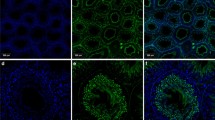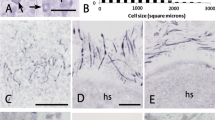Abstract
Acid-sensing ion channel 2 (ASIC2) plays a role as a mechanorecptor and acid receptor in the peripheral and central nervous systems. However, several recent studies have suggested that ASIC2 is expressed in several organs, in addition to the nervous system. We have examined the expression and distribution of ASIC2 in rat ciliated cells (trachea and oviduct) and stereociliated cells (epididymis, Corti organ, and ampullary crest) by immunohistochemistry and transmission electron microscopy (TEM). Imunohistochemistry revealed that ASIC2 was expressed in both ciliated cells and stereociliated cells, but the localization differed between these cell types. In ciliated cells, ASIC2 was coexpressed with a cilial marker (acetylated tubulin). In stereociliated cells stained with a stereocilial marker (phalloidin), ASIC2 was observed in the cell body. Observation by TEM suggested that ASIC2 expression was present at the apical side of the cilial membrane in ciliated cells and at the apical side of the cell body in stereociliated cells. This study thus indicates that the proton receptor ASIC2 is expressed in both ciliated and stereociliated cells.




Similar content being viewed by others
References
Adams CM, Anderson MG, Motto DG, Price MP, Johnson WA, Welsh MJ (1998) Ripped pocket and pickpocket, novel Drosophila DEG/ENaC subunits expressed in early development and in mechanosensory neurons. J Cell Biol 140:143–152
Alvarez de la Rosa D, Zhang P, Shao D, White F, Canessa CM (2002) Functional implications of the localization and activity of acid-sensitive channels in rat peripheral nervous system. Proc Natl Acad Sci USA 99:2326–2331
Babinski K, Catarsi S, Biagini G, Seguela P (2000) Mammalian ASIC2a and ASIC3 subunits co-assemble into heteromeric proton-gated channels sensitive to Gd3+. J Biol Chem 275:28519–28525
Bassler EL, Ngo-Anh TJ, Geisler HS, Ruppersberg JP, Grunder S (2001) Molecular and functional characterization of acid-sensing ion channel (ASIC) 1b. J Biol Chem 276:33782–33787
Canessa CM, Merillat AM, Rossier BC (1994) Membrane topology of the epithelial sodium channel in intact cells. Am J Physiol 267:C1682–C1690
Champigny G, Voilley N, Waldmann R, Lazdunski M (1998) Mutations causing neurodegeneration in Caenorhabditis elegans drastically alter the pH sensitivity and inactivation of the mammalian H+-gated Na+ channel MDEG1. J Biol Chem 273:15418–15422
Chen CC, England S, Akopian AN, Wood JN (1998) A sensory neuron-specific, proton-gated ion channel. Proc Natl Acad Sci USA 95:10240–10245
Clayton J, Jack CI, Ryall C, Tran J, Hilal E, Gosney M (2006) Tracheal pH monitoring and aspiration in acute stroke. Age Ageing 35:47–53
Corey DP (2006) What is the hair cell transduction channel? J Physiol (Lond) 576:23–28
Coscoy S, Weille JR de, Lingueglia E, Lazdunski M (1999) The pre-transmembrane 1 domain of acid-sensing ion channels participates in the ion pore. J Biol Chem 274:10129–10132
Crawford AC, Evans MG, Fettiplace R (1991) The actions of calcium on the mechano-electrical transducer current of turtle hair cells. J Physiol (Lond) 434:369–398
Garcia-Anoveros J, Derfler B, Neville-Golden J, Hyman BT, Corey DP (1997) BNaC1 and BNaC2 constitute a new family of human neuronal sodium channels related to degenerins and epithelial sodium channels. Proc Natl Acad Sci USA 94:1459–1464
Geleoc GS, Lennan GW, Richardson GP, Kros CJ (1997) A quantitative comparison of mechanoelectrical transduction in vestibular and auditory hair cells of neonatal mice. Proc Biol Sci 264:611–621
Hildebrand MS, Silva MG de, Klockars T, Rose E, Price M, Smith RJ, McGuirt WT, Christopoulos H, Petit C, Dahl HH (2004) Characterisation of DRASIC in the mouse inner ear. Hear Res 190:149–160
Jahr H, Driel M van, Osch GJ van, Weinans H, Leeuwen JP van (2005) Identification of acid-sensing ion channels in bone. Biochem Biophys Res Commun 337:349–354
Jayaraman S, Song Y, Verkman AS (2001) Airway surface liquid pH in well-differentiated airway epithelial cell cultures and mouse trachea. Am J Physiol Cell Physiol 281:C1504–C1511
Kawamata T, Ninomiya T, Toriyabe M, Yamamoto J, Niiyama Y, Omote K, Namiki A (2006) Immunohistochemical analysis of acid-sensing ion channel 2 expression in rat dorsal root ganglion and effects of axotomy. Neuroscience 143:175–187
Kros CJ, Rusch A, Richardson GP (1992) Mechano-electrical transducer currents in hair cells of the cultured neonatal mouse cochlea. Proc Biol Sci 249:185–193
Lingueglia E (2007) Acid-sensing ion channels in sensory perception. J Biol Chem 282:17325–17329
Lingueglia E, Weille JR de, Bassilana F, Heurteaux C, Sakai H, Waldmann R, Lazdunski M (1997) A modulatory subunit of acid sensing ion channels in brain and dorsal root ganglion cells. J Biol Chem 272:29778–29783
Lumpkin EA, Marquis RE, Hudspeth AJ (1997) The selectivity of the hair cell’s mechanoelectrical-transduction channel promotes Ca2+ flux at low Ca2+ concentrations. Proc Natl Acad Sci USA 94:10997–11002
Maas DH, Storey BT, Mastroianni L Jr (1977) Hydrogen ion and carbon dioxide content of the oviductal fluid of the rhesus monkey (Macaca mulatta). Fertil Steril 28:981–985
Mano I, Driscoll M (1999) DEG/ENaC channels: a touchy superfamily that watches its salt. Bioessays 21:568–578
Price MP, Snyder PM, Welsh MJ (1996) Cloning and expression of a novel human brain Na+ channel. J Biol Chem 271:7879–7882
Price MP, Lewin GR, McIlwrath SL, Cheng C, Xie J, Heppenstall PA, Stucky CL, Mannsfeldt AG, Brennan TJ, Drummond HA, Qiao J, Benson CJ, Tarr DE, Hrstka RF, Yang B, Williamson RA, Welsh MJ (2000) The mammalian sodium channel BNC1 is required for normal touch sensation. Nature 407:1007–1011
Renard S, Lingueglia E, Voilley N, Lazdunski M, Barbry P (1994) Biochemical analysis of the membrane topology of the amiloride-sensitive Na+ channel. J Biol Chem 269:12981–12986
Ricci AJ, Fettiplace R (1998) Calcium permeation of the turtle hair cell mechanotransducer channel and its relation to the composition of endolymph. J Physiol (Lond) 506:159–173
Roza C, Puel JL, Kress M, Baron A, Diochot S, Lazdunski M, Waldmann R (2004) Knockout of the ASIC2 channel in mice does not impair cutaneous mechanosensation, visceral mechanonociception and hearing. J Physiol Lond) 558:659–669
Salt AN (2001) Dynamics of the inner ear fluid. In: Jahn AFP, Santos-Sacchi J (eds) Physiology of the ear. Singular, New York, pp 333–355
Strassmaier M, Gillespie PG (2002) The hair cell’s transduction channel. Curr Opin Neurobiol 12:380–386
Ugawa S, Minami Y, Guo W, Saishin Y, Takatsuji K, Yamamoto T, Tohyama M, Shimada S (1998) Receptor that leaves a sour taste in the mouth. Nature 395:555–556
Ugawa S, Inagaki A, Yamamura H, Ueda T, Ishida Y, Kajita K, Shimizu H, Shimada S (2006) Acid-sensing ion channel-1b in the stereocilia of mammalian cochlear hair cells. Neuroreport 17:1235–1239
Waldmann R, Champigny G, Voilley N, Lauritzen I, Lazdunski M (1996) The mammalian degenerin MDEG, an amiloride-sensitive cation channel activated by mutations causing neurodegeneration in Caenorhabditis elegans. J Biol Chem 271:10433–10436
Waldmann R, Champigny G, Bassilana F, Heurteaux C, Lazdunski M (1997) A proton-gated cation channel involved in acid-sensing. Nature 386:173–177
Acknowledgements
We thank Ms. E. Suzuki (Sapporo Medical University) for technical support.
Author information
Authors and Affiliations
Corresponding author
Additional information
This research was partially supported by the Ministry of Education, Science, Sports and Culture, Grant-in-Aid for Young Scientists (B), 20700429, 2008.
Rights and permissions
About this article
Cite this article
Kikuchi, S., Ninomiya, T., Kawamata, T. et al. Expression of ASIC2 in ciliated cells and stereociliated cells. Cell Tissue Res 333, 217–224 (2008). https://doi.org/10.1007/s00441-008-0635-3
Received:
Accepted:
Published:
Issue Date:
DOI: https://doi.org/10.1007/s00441-008-0635-3




